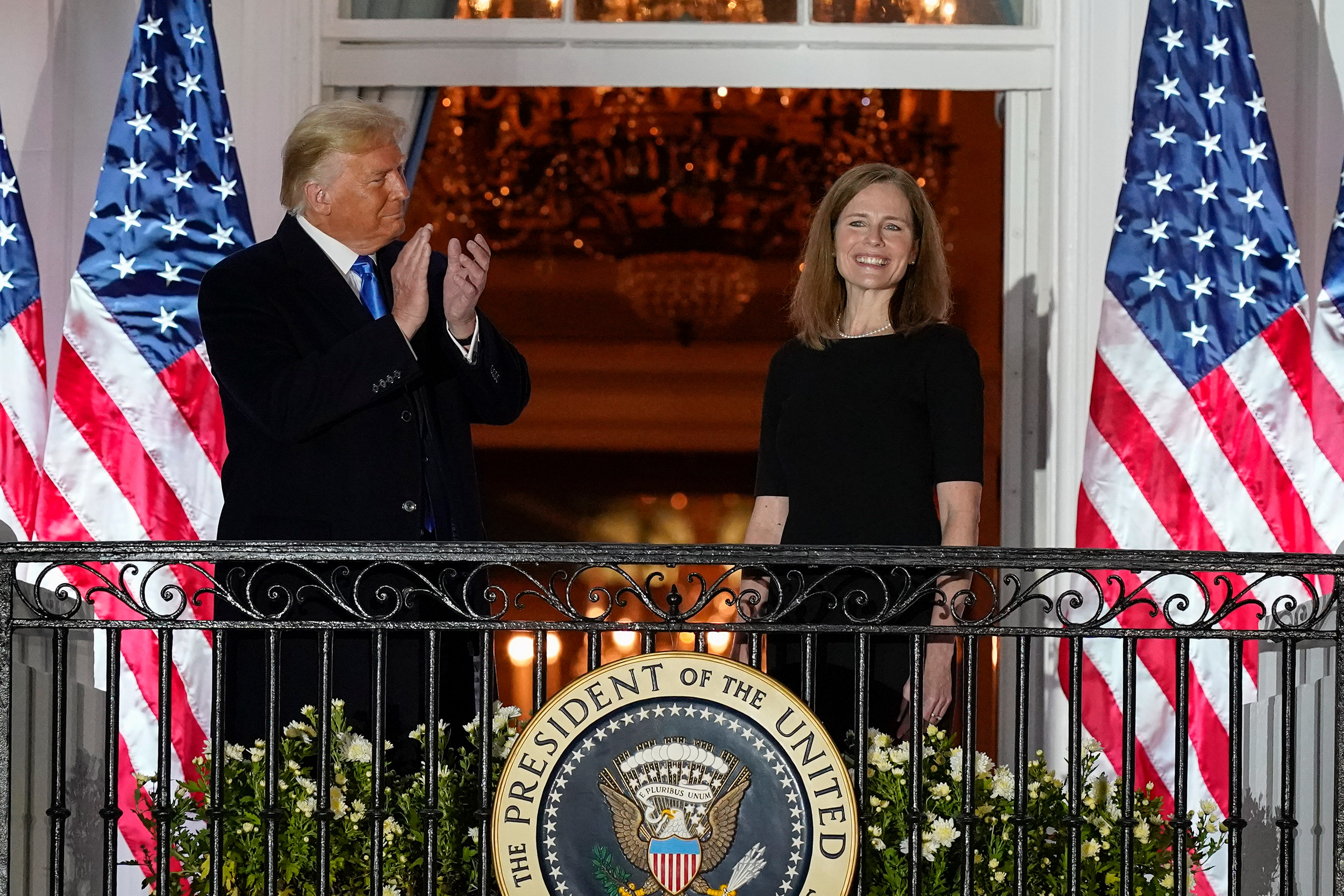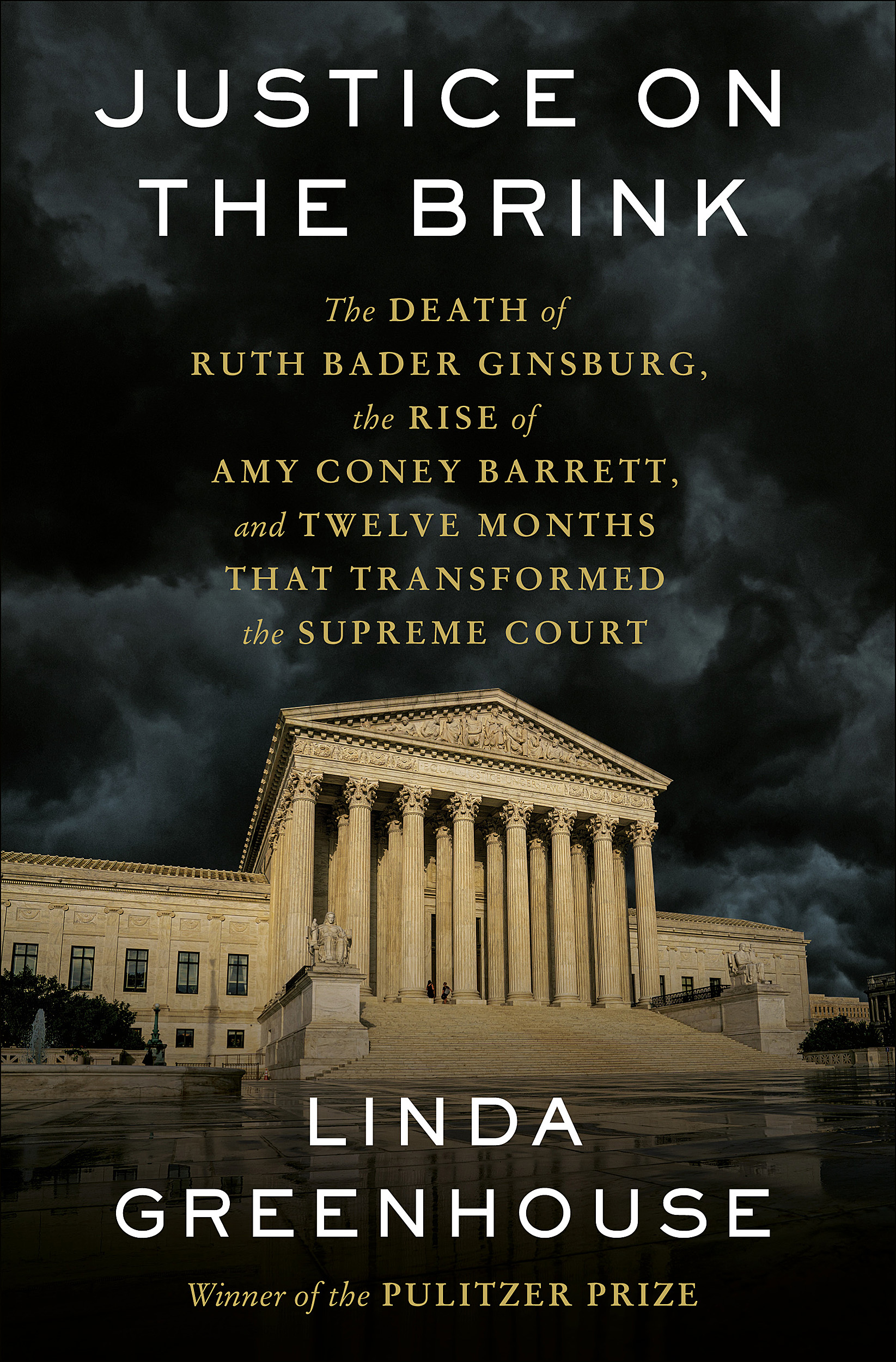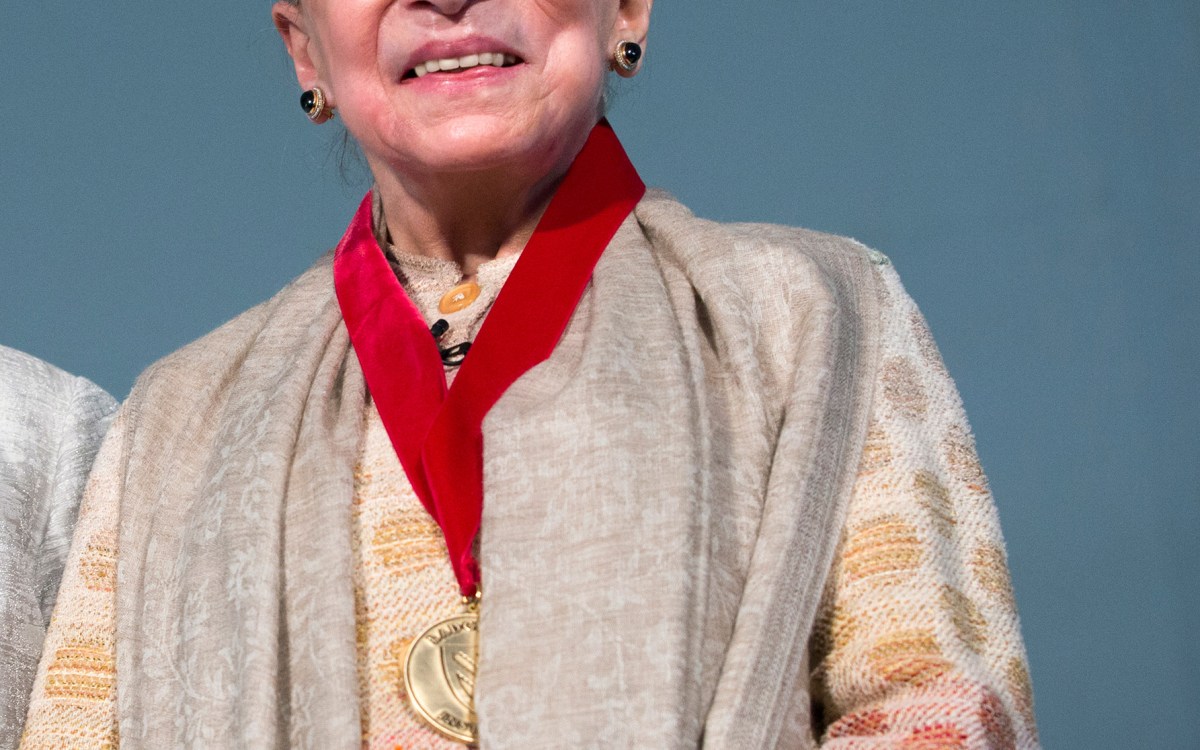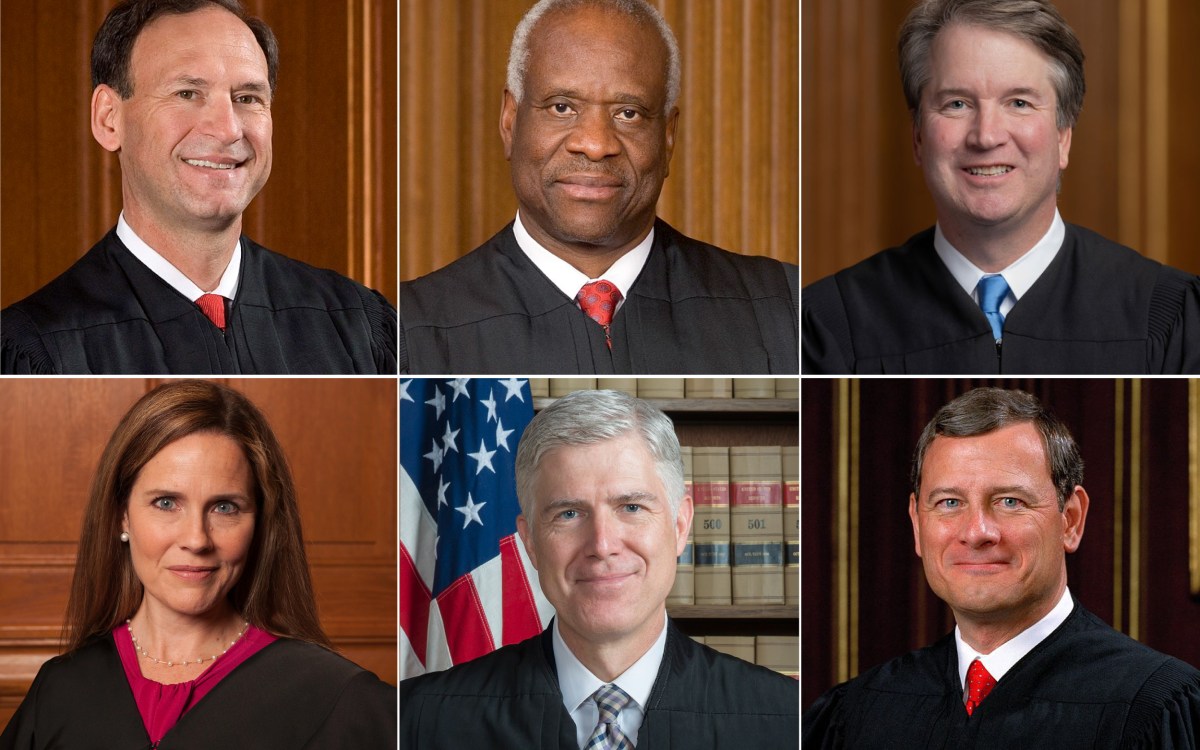
President Donald Trump and Amy Coney Barrett stand on the Blue Room Balcony after Supreme Court Justice Clarence Thomas administered the Constitutional Oath on Oct. 26, 2020.
AP Photo/Alex Brandon
The chosen one: Amy Coney Barrett
Linda Greenhouse traces forces that made near certain rise of newest — and undeniably consequential — Supreme Court justice
Excerpted from “Justice on the Brink: The Death of Ruth Bader Ginsburg and the Rise of Amy Coney Barrett and Twelve Months That Transformed the Supreme Court” by Linda Greenhouse ’68, published by by Random House, an imprint and division of Penguin Random House LLC.
The late October sky had grown dark, but the lights aimed at the White House were so bright that on the Truman Balcony it might have been high noon. She stood bathed in the glow, the president by her side, he bundled in a heavy coat against the evening chill and she in a short-sleeved black dress that brushed the top of her knees. Her light brown hair fell straight to her shoulders. She looked younger than her 48 years. Barely an hour earlier, by a near party-line vote of 52 to 48, the Senate had confirmed her to a Supreme Court seat that had been empty for the mere five weeks since the death of the woman who had occupied it for 27 years, Justice Ruth Bader Ginsburg.
Not for 151 years had the Senate confirmed a Supreme Court nominee without a single vote from the minority party. For the Democratic senators, who had refused on principle to show up for the Judiciary Committee vote, filling a Supreme Court vacancy eight days away from a presidential election was an illegitimate exercise of power. But to Senator Mitch McConnell, Republican of Kentucky, the majority leader who during the past four years had shepherded more than 200 of President Donald Trump’s nominees to their life-tenured seats on the federal bench, it was the reason he was there.
The Truman Balcony tableau, Democrats would grumble the next morning, was the ultimate photo op, breathtaking in its audacity; the country had never seen anything like it. True enough. But on the other hand, was it really so astonishing? The country was witnessing something new, yes. But what was really on display was the culmination of a project launched years before, one that had been set on a path carefully planned, tended, and laid out for all to see — except, of course, that most people weren’t looking, or, if they were, they mistook occasional setbacks for lasting defeat. It was a project by a group of conservative lawyers called the Federalist Society to take back the Supreme Court, and the woman on the balcony was its instrument. She was Amy Coney Barrett, the chosen one.
There are few inevitable events in politics, but in retrospect it’s tempting to see Barrett’s nomination to the Supreme Court as one of them. Long before Trump’s announcement of her selection in the White House Rose Garden on Sept. 26—the celebratory event that became a notorious COVID-19 superspreader — he had made it clear that he would name her to the Supreme Court if he got the chance. When Justice Anthony Kennedy retired two years earlier, Barrett, who had taken her seat only months before on the federal appeals court in Chicago, appeared on the president’s short list for the vacancy. But Trump chose instead another appeals court judge, Brett Kavanaugh. “I’m saving her for Ginsburg,” he explained, words intended to assure any disappointed members of his base that while the devoutly Catholic mother of seven had been passed over for this vacancy, she would not be overlooked the next time.
The question, of course — really the only question — was whether there would be a next time. Not since Richard Nixon had there been three Supreme Court vacancies in a president’s first term. But no one could rule it out. The recent history of Supreme Court nominations was filled with the unexpected. Justice Antonin Scalia, revered on the right, had died unexpectedly in February 2016, near the start of President Barack Obama’s final year in office. Barely an hour after word came of the justice’s death, well before most Americans had even heard the news on that Saturday afternoon, McConnell had declared that he would not permit the president to fill the vacancy. “The American people should have a voice in the selection of their next Supreme Court justice,” McConnell said. “Therefore, this vacancy should not be filled until we have a new president.”
It was an eyebrow-raising, norm-shattering proposition. While it was generally assumed that the Supreme Court confirmation door would close at some point during an election year, no one had questioned the propriety of filling a seat only a few months in. The Senate never gave a hearing to Obama’s nominee, Merrick Garland, chief judge of the federal appeals court in Washington, D.C., a widely admired figure who had drawn praise in the past from leading Republicans, suddenly grown silent.
Eleven days after taking office, Trump nominated Neil Gorsuch, a judge on the federal appeals court in Denver, for the Scalia vacancy. When Democrats threatened a filibuster to protest filling what they deemed a stolen seat, the Republican majority changed the rules and abolished the filibuster for Supreme Court nominations. Gorsuch was confirmed by a vote of 54 to 45 (60 votes would have been required to break a filibuster), and Kavanaugh — like Garland a judge on the U.S. Court of Appeals for the District of Columbia Circuit — was confirmed to the Kennedy vacancy the next year.
That year passed without a retirement, and when the 2019–20 term ended on July 9 without a retirement announcement, it appeared that there would be no Supreme Court vacancy during the remainder of Trump’s first term. The public was unaware that Ginsburg, at 87 the oldest member of the court and the senior member of its increasingly beleaguered liberal bloc, was fighting what would be the last of her numerous battles with cancer. Nine weeks later, on Sept. 18, Ginsburg died of metastatic pancreatic cancer.
“Justice on the Brink” examines Amy Coney Barrett’s path to — and effect on — the Supreme Court.
Image courtesy of Random House

For McConnell, this was a time not for mourning, but for business, and he was ready. The president was in the air, flying back from a campaign rally in Minnesota. The White House operator patched McConnell’s urgent call through to Air Force One. As Josh Holmes, McConnell’s former chief of staff, later told the PBS documentary program “Frontline,” the majority leader delivered a two-part message: “I’m going to put out a statement that says we’re going to fill the vacancy” and “You’ve gotta nominate Amy Coney Barrett.”
Why Barrett? The answer was obvious, although as yet unspoken; there were motions to go through, after all. The fact was that by September 18, 2020, in every way that mattered, she was the perfect choice.
Gorsuch and Kavanaugh had been strikingly conventional choices. Both had clerked on the Supreme Court. Both were creatures of the Beltway who had paid their dues in Republican politics and worked at high levels in the administration of President George W. Bush, Gorsuch in the Justice Department as principal deputy to the associate attorney general and Kavanaugh in the White House as staff secretary to the president. Bush rewarded each with a federal appellate judgeship, and each had spent more than a decade on the bench.
Barrett also clerked on the Supreme Court, but there the similarity ended. By traditional Republican standards, she was far from a conventional choice. She lacked the Ivy League credentials shared by every other sitting justice, all of whom were law graduates of either Harvard (Roberts, Stephen Breyer, Elena Kagan, Gorsuch) or Yale (Thomas, Samuel Alito, Sonia Sotomayor, Kavanaugh.)
Barrett graduated from law school at the University of Notre Dame, having turned down an offer of admission from the higher-ranked University of Chicago Law School. “I’m a Catholic, and I always grew up loving Notre Dame,” she explained years later, adding: “I really wanted to choose a place where I felt like I was not going to be just educated as a lawyer. I wanted to be in a place where I felt like I would be developed and inspired as a whole person.” A commencement speech she gave there in 2006, nine years after her own graduation, made clear the distinctive view she held of her alma mater. “Keep in mind,” she told the graduating students, “that your legal career is but a means to an end.” That end, she explained, “is building the kingdom of God.”
Compared with other recent Supreme Court nominees of both Republican and Democratic presidents, her résumé was thin. She had been a judge for a few months short of three years. She had practiced law only briefly, spending the two years following her clerkship as an associate in a Washington, D.C., law firm. She had never worked in government. After her time in Washington, she returned to the shelter of Notre Dame and spent 15 years on the law school’s faculty.
That Barrett was Catholic was hardly unusual. Quite the contrary, in fact; she would be joining a court on which six of the eight justices were raised in the church: Chief Justice Roberts and Justices Alito, Sotomayor, Thomas, Kavanaugh, and Gorsuch.
What was unusual was the public dimension to Barrett’s Catholicism, her willingness during her pre-judicial career to attest to her adherence to Catholic doctrine on matters of public concern, abortion prominently among them. In 2013, on the 40th anniversary of the Supreme Court’s Roe v. Wade decision, which established the constitutional right to abortion, Barrett signed a statement placed in the Notre Dame student newspaper by the University Faculty for Life and the Notre Dame Fund to Protect Human Life. “In the 40 years since the Supreme Court’s infamous Roe v. Wade decision, over 55 million unborn children have been killed by abortions,” the statement read. “We faculty and staff at the University of Notre Dame reaffirm our full support for our University’s commitment to the right to life, we renew our call for the unborn to be protected in law and welcomed in life, and we voice our love and support for the mothers who bear them.”
“Why Barrett? The answer was obvious, although as yet unspoken; there were motions to go through, after all. The fact was that by September 18, 2020, in every way that mattered, she was the perfect choice.”
The previous year, she had signed a statement criticizing the Obama administration for its implementation of the Affordable Care Act’s requirement to include contraception coverage in employer-sponsored health plans. Religious orders and churches themselves were exempt from the mandate, and religiously affiliated organizations like colleges and the chain of nursing homes run by an order of nuns, the Little Sisters of the Poor, were demanding the same exemption. The Obama administration offered them instead a hands-off “accommodation” under which, without the employer’s involvement, an organization’s insurance provider would underwrite the coverage and inform employees of its availability.
The statement Barrett signed in opposition to this policy, under the headline “UNACCEPTABLE,” was drafted and circulated by the Becket Fund for Religious Liberty, a prominent organization that litigates against what it perceives as government incursions on the rights of believers. The statement labeled the Obama policy “a grave violation of religious freedom,” adding: “It is an insult to the intelligence of Catholics, Protestants, Eastern Orthodox Christians, Jews, Muslims, and other people of faith and conscience to imagine that they will accept an assault on their religious liberty if only it is covered up by a cheap accounting trick.”
In 2016, the University Faculty for Life, of which she was then a member, unanimously passed a resolution condemning Notre Dame’s decision to give Vice President Joe Biden the Laetare Medal, awarded annually to “an American Catholic in recognition of outstanding service to Church and society.” How could the vice president meet that qualification, the group demanded, when he “has for decades conspicuously rejected Church teaching about life” by supporting the right to abortion?
To a member of the general public reading these statements, it may have mattered little that one participant happened to be an obscure law professor. But Don McGahn was not a disinterested observer. He was a Notre Dame graduate himself and a member of the conservative Federalist Society, serving as Trump’s White House counsel. He was the administration’s chief judge-picker, and he had dozens of appeals court seats to fill, positions the Senate had prevented Obama from filling. One was an Indiana seat on the Seventh Circuit. Obama had attempted to fill that seat by nominating Myra Selby, the first woman and first African American to serve on the Indiana Supreme Court. The Senate’s Republican majority had never given her a hearing, so the seat was available to McGahn. The Trump administration was less than four months old when Barrett’s nomination was announced on May 8, 2017.
During her hearing before the Senate Judiciary Committee that September, the question of religion loomed large, as it did on the dockets of federal courts around the country. Republican-controlled state legislatures were enacting dozens of antiabortion measures, many now being challenged in court. Roe v. Wade itself was seen as increasingly vulnerable. Multiple courts were also dealing with the ongoing religious challenges to the Affordable Care Act’s contraception mandate.
Democratic senators were openly skeptical about whether Barrett could set aside her deep religious commitments and, as a judge, address such questions with an open mind. Her assurances that she could failed to persuade Senator Dianne Feinstein of California, the committee’s ranking Democrat. Feinstein asked her: “Why is it that so many of us on this side have this very uncomfortable feeling that—you know, dogma and law are two different things. And I think whatever a religion is, it has its own dogma. The law is totally different. And I think in your case, professor, when you read your speeches, the conclusion one draws is that the dogma lives loudly within you, and that’s of concern when you come to big issues that large numbers of people have fought for years in this country.”
Feinstein’s words proved a gift to the Republican Party, provoking an immediate and sustained backlash. Op-ed commentary portrayed the senator, and by extension all the Democrats, as anti-Catholic, even anti-religion. Coffee mugs and T-shirts sold in Catholic bookstores and over the Internet bore the words “The dogma lives loudly within me.” When McGahn spoke at Barrett’s Seventh Circuit investiture ceremony, held at Notre Dame, he took the occasion to quip: “We now affectionately call her Judge Dogma.”
In retrospect, Feinstein’s clumsy question might have been the best thing that happened to Barrett in her first venture into the public spotlight. People who would scarcely have noticed a Seventh Circuit appointment amid the chaos of Trump’s early months in office now knew her name. The meme of Catholic martyrdom that was now attached to that name resonated powerfully with the theme of Christian victimhood that Trump had so successfully exploited during his rise to power. It isn’t necessary to claim that it influenced her confirmation to the Seventh Circuit, a foregone conclusion in any event. But beyond doubt it helped make her next chapter inevitable.
Copyright © 2021 by Linda Greenhouse. All rights reserved.








